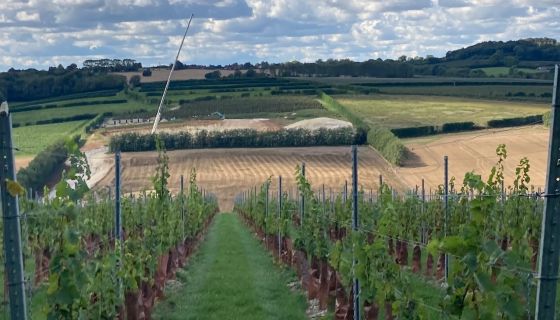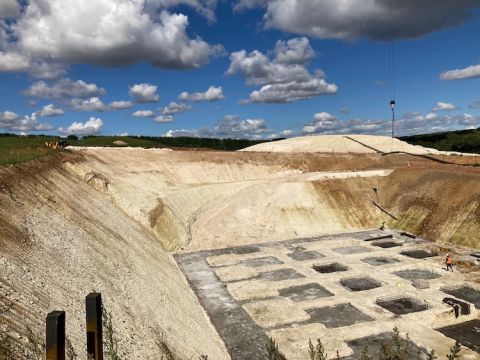With the proliferation of vineyards in England and Wales – leading viticultural consultant Stephen Skelton reckons there are about a thousand of them now – many Brits with a little bit of land may be wondering whether it would be suitable for wine production.
Vines produce suitable grapes for wine on topsoils that are not too rich and ideally, in damper corners of Britain, over something free-draining such as chalk or greensand. Vines need to suffer a bit to be persuaded to put their energy into producing fruit rather than leaves, so shouldn’t stand in water. Cranfield University has developed a fascinatingly detailed free dataset, Soilscapes, that can deliver information on the fertility, drainage status and texture of soils in even very small areas anywhere in England and Wales. Very useful for would-be vignerons.
But what’s below the surface is just one factor and, as Skelton points out, you can always fiddle with the soil anyway by, for instance, adding what’s missing or draining it. More important is that the location ensures that the vines stand a chance of actually ripening the grapes. This can be impossible in northern England, and even in southern counties, which benefit from warmer summers, the land should face south to maximise sunlight and therefore photosynthesis. It should ideally be no more than 100 metres (330 ft) above sea level – any higher and the nights will probably be too cool. Frost is one of the greatest hazards for any British vine-grower so the air drainage offered by a slope is useful – though not one too mercilessly buffeted by wind – and frost pockets should definitely be avoided.
But that didn’t stop 1.7 million vines being planted last year alone according to the industry organisation WineGB, which also reports that sales rose 69% between 2019 and 2021. The old problem with English wine, that the grapes had such a struggle to ripen that the wines were uncomfortably tart, has virtually disappeared thanks to global warming. In fact so warm were the summers of 2018, 2020 and 2022 that British winemakers no longer have to concentrate on making sparkling wines, in which high acid is an asset. We are starting to see a plethora of very respectable still wines, even red wines, which generally need more heat to ripen the grapes fully.
Buying, selling and renting vineyard land has become so commercially significant that property consultants Knight Frank now, uniquely, have a ‘partner and head of viticulture’. Ed Mansel Lewis reports a noticeable evolution in the sort of people he sees going into grape-growing. ‘It used to be people who wanted to be like Russell Crowe in A Good Year’, he told me, referring to the film about inheriting a Provence wine château, ‘but now it’s people with a plan for how to position and sell a brand. They may have done it already for a commodity other than wine. Or people who already have a distribution system in place.’ Yes, English wine has definitely grown up from the ‘let’s plant Priscilla’s paddock’ brigade.
One of the most ambitious of the new breed of English vignerons is Mark Driver who, with his wife Sarah, in 2010 began to convert their Hong Kong fortune into Rathfinny Estate, 350 acres (142 ha) of vineyard on the South Downs outside Brighton. He has just succeeded in achieving PDO status for his county, Sussex. A PDO is EU parlance for a protected designation of origin, something that used to be called an appellation. With the late Mike Roberts of Ridgeview wine estate, Driver started his campaign in 2015 but it was derailed by the Brexit vote and for a while ‘the application sat at the bottom of a big pile of PDO applications in Brussels’. But by July this year he had managed to push it through UK government bureaucracy so that now the name Sussex for a wine is protected from misuse or imitation, and any wine labelled Sussex PDO has to be analysed and pass a taste test.
This has not been universally welcomed by wine producers outside Sussex, some of whom argue that the county boundary is political not geographical, and includes all sorts of land unsuitable for viticulture. (European PDOs tend to be much more specific in the territory designated.) They’re also concerned presumably by the implication that Sussex wine is superior to the rest.
Mansel Lewis claims the Sussex PDO ‘upset a lot of people in Kent’, the county to the immediate east of Sussex, which also prides itself on its chalky downland, chosen by the most high-profile investment in English vineyard land by a major Champagne house, Taittinger’s Domaine Evremond outside Chilham – where I saw the massive excavations in chalk shown above for a three-storey winery and visitor centre the other day. Evremond is one of eight top Kentish wine producers who have formed a promotional body called the Wine Garden of England. (The others are Balfour, Biddenden, Chapel Down, Gusbourne, Simpsons, Squerryes and Westwell.) According to Taittinger’s representative in England, Master of Wine Patrick McGrath, these eight producers are considering launching an application for their own Kent PDO. Corkscrews at dawn…
Dr Alistair Nesbitt is a climatologist. His company Vinescapes recently published climate-change predictions specific to viticulture and suggests there may be suitable terroirs in Hertfordshire, Cambridgeshire and the Severn Valley in the future, when yields are expected to become much less irregular than they have been, with 2022 forecast to reach record levels of both quality and quantity.
I asked Mansel Lewis whether there was still promising vineyard land in England that was as yet unexploited and he immediately cited a string of Kentish villages – Hollingbourne, Detling, Old Wives Lees (at which point I thought he was pulling my leg), Boxley and Mereworth – as well as one in Essex, Althorne.
Like Kent and Sussex, Hampshire has quite a concentration of the UK’s 197 wineries while Essex doesn’t have that many, but Essex is increasingly admired as a source of ripe grapes, many of which are bought by wine producers outside the county, with the Crouch Valley near Maldon being reckoned the warmest, driest part of England for viticulture. One relatively new Essex winery, Danbury Ridge, founded by Michael Bunker, coincidentally formerly of GAM Investments in Hong Kong like Driver of Rathfinny, has arguably done for still English wine what the Sussex Nyetimber wine estate did for English sparkling wine in the 1990s. Danbury Ridge’s still 2018 Chardonnays and Pinot Noirs have shown what English soil can yield: fully ripe, very respectable wines worthy of lavish oak treatment in the Burgundian fashion.
Currently more than 60% of English and Welsh wine is sparkling because high acidity, which has been endemic in grapes grown in the cool British climate, is a virtue in sparkling wine – and the great majority of it is made to more or less the same recipe as champagne. The result is that the category is pretty homogeneous, and no bargain since this traditional method of making wine fizzy demands time, and space in which at least two or three years’ worth of production can be stored.
One outfit, Vineyard Farms Ltd, defiantly uses the same cheaper, quicker Charmat (or tank) method of making sparkling wine as Prosecco. The gaudily labelled Harlot retails at about £13 a bottle, a fraction of most English fizz, which tended to strike many consumers as expensive – until champagne prices went through the roof. The company is acquiring land in Essex, claiming it will be the biggest producer of English wine by 2025, making up to five million bottles a year.
Chapel Down, which currently claims to be ‘England’s leading and largest wine maker’, may have something to say about this. But when an industry is riven by conflict then it can presumably be said to have truly grown up.
English still wines
It’s always worth trying the winery websites or cellar doors for best prices and condition of bottles.
Balfour, Springfield Chardonnay 2018 12%
£25 Laithwaites, Averys Wine Merchants
Danbury Ridge Chardonnay 2018 14%
£31.95 Uncorked
Danbury Ridge Pinot Noir 2018 13.5%
£33.95 Uncorked, £34 Berry Bros & Rudd
Danbury Ridge, Octagon Pinot Noir 2018 13.5%
£55.50 Luckins
Freedom of the Press Chardonnay 2020 13%
£24 producer's website
Gusbourne, Guinevere Chardonnay 2019 12.5%
£28.95 Waddesdon Manor and others
Hattingley Valley, Still by Hattingley Chardonnay 2020 12.6%
£20 producer's website
Lyme Bay, Bacchus Block 2020 12.5%
£15.50 Just Fine Wines, £17.95 Fareham Wine Cellar
Lyme Bay Pinot Noir 2020 12.5%
£25.50 Fareham Wine Cellar, £27 The English Wine Collection
Nutbourne Bacchus 2019 12%
£14.99 Grape Britannia
Simpsons, Derringstone Pinot Meunier 2021 12.5%
£19.47 Strictly Wine, £138 per case of 6 producer's website
Simpsons, Q Class Chardonnay 2020 13%
£100 per magnum producer's website
For tasting notes see our database of 210,000+ wine reviewed on Purple Pages. For more stockists see Wine-Searcher.com.















